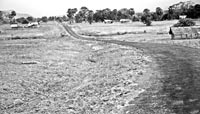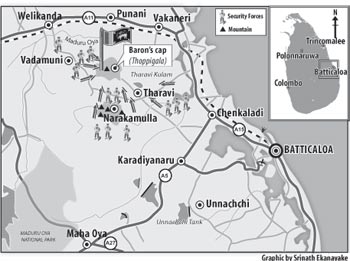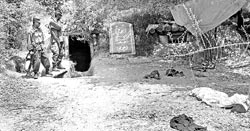
Black July turns to gold in ToppigalaThe Sunday Times team joins brave troops in final push for key area We visited the Toppigala region just prior to Wednesday’s capture together with colleagues from Lankadeepa. During the greater part of our stay, the two teams covered different areas, separately. Last Sunday afternoon on reaching the region, the first place we visited was the Karadiyanaru base complex of the LTTE on the Chenkalady-Maha Oya A-5 highway. It had been captured from the Tigers only two weeks earlier. For the capture of Toppigala region proper it had finally become the forward base of the security forces and by Sunday it was becoming a hive of activity with the arrival of media teams, mainly from electronic media, sensing the imminent fall of Toppigala to the security forces. After enjoying some military hospitality we proceeded down the A-5 highway, accompanied by military media liaison officer Wasantha Siriwardena.
We proceeded to the outskirts of the first Sinhala village on this route, Tampitiya. Here we turned back as it was already around 6 p.m. and we had to proceed to Batticaloa to spend the night there as Karadiyanaru was already crowded with teams from Rupavahini, ITN, Swarnavahini etc. converging there. From Rukam tank to Maha Oya, where the STF is holding the ground, they have made a clean bulldozer sweep of the road on either side to a depth of about 100 metres to prevent any Tigers infiltrators from planting claymore mines. Though Batticaloa town is some miles away, the thud of periodic firing of artillery into Toppigala hills could be clearly heard throughout the night. As a sign of the unfolding scenario the following night we heard firing at much shorter intervals. On Monday morning, when we returned to Karadiyanaru we got a briefing from leading ground commanders and it couldn’t have been any clearer about the imminent outcome. Said one top commander: “Black July (obviously referring to July ’83 riots) will be turned into a golden July”. When pressed to give a more definite answer, he vaguely said that it would fall in about five days. But by the following evening, when we were about to leave along with all the foreign media personnel, they were already making the final moves from Welikanda side, unknown to us. We saw a group of commanders in full battle gear speeding away with their escorts from the base as we were leaving Karadiyanaru. Obviously, officers and men who were risking their lives and limbs in the frontlines for the country were very sensitive to what they said were attempts to belittle their achievements. Their concerns were at such a peak that one TV crew was asked to leave the area immediately on Tuesday morning following an alleged distortion of a news report. The other result of the incident was that all remaining journalists too were barred from going beyond a certain point, which was wide open to us only the previous day.
A top eastern commander, who did not want to be identified, said they were not seeking individual publicity or rewards for what they have achieved, but others should not humiliate the brave soldiers who captured the LTTE’s main eastern training base that served as the incubator for the terrorist organization. “They can get-together and address the long neglected grievances of Tamils, but do not belittle the accomplishments of our fighting men,” was his parting comment. Besides, another senior military officer said if the area was not cleared of Tigers, Batticaloa town would once again come under LTTE artillery fire as happened on February 28, when a group of diplomats were taken to see the development work being carried out there. Our tour of some of the captured areas on Monday and Tuesday clearly showed that this was a major staging area for the LTTE. The area had been so important to the LTTE that it had built a road, better than most roads in the country, from Karadiyanaru right up to Toppigala rock, stretching at least 21 kilometres. While retreating the Tigers had blasted two of the bridges on this route, but army engineers have partially restored them for vehicular traffic. We were able to proceed about 15 kilometres down this road from Karadiyanaru and come within sight of Toppigala. We were not allowed to proceed any further as the area beyond that point had not been cleared. The Toppigala complex certainly had been an incubator of a sort. In one abandoned Tiger mini camp, which also housed their main jail, we saw a short firing range where they had trained their pistol cadres, who are responsible for so many assassinations in civilian areas. We ourselves managed to pick up a few empty 9mm bullet casings from this firing range as souvenirs. And some of the targets drawn on metal sheets were yet standing, while others had been knocked down by the soldiers. After a bone crushing ride on a Buffel troop carrier on a gravel road, which was just beyond the second blasted bridge, we reached an army artillery base at one of the Narakamulla hills (Renamed as the LTTE’s Tora Bora complex by Karuna). The hill itself had been the headquarters of Tiger Leader Nagesh. Though it had been such an important location, because of the heavy tree cover nothing could be seen from the air or open ground on its approaches. Nagesh’s headquarters is now home to one of the military units guarding the artillery. Among the comforts Nagesh had enjoyed, though it was in the middle of no where, was a fairly modern tiled toilet with running water, with even a bath tub made of bricks and again tiled. He also had a choice of a squatting pan and a commode.Thanks to much of the facilities left behind intact by fleeing Nagesh and his men, the place also serves as a main field kitchen. According to Lt. P.K.R.U. Rupasingha, who is the welfare officer of this unit, he prepares as many as 600 meals at a time for soldiers serving within a radius of 15 kilometres. The jovial and obliging man certainly served a wonderful rice and curry meal for the visiting journalists and their crew on Tuesday. We couldn’t believe the army could do so much despite it being so close to the front. The previous day we were served equally delicious short eats from the same camp. We also saw fighting units going through some trying conditions. A group of commandos who had just cleared one of the last Narakamulla hills early on Monday were seen eating meagre field rations. Some of the men who had been spearheading the fight were surviving for days on field ration packs. A young sergeant major who had led the unit in the operation was obviously taking a nap under a bush and hanging near him was a Mickey Mouse bag, probably given to him by his girlfriend as a good luck charm. On being informed about our arrival, he quickly sprung from his perch and readily organized some drinks for us.
In that Monday early morning operation one of the men lost a leg to an anti-personnel mine as he had stepped outside a jungle path. Later that afternoon we too were taken on that route with strict instructions not to step out of the trail as army engineers had still not cleared the area. As we passed the place the victim’s half blown boot was lying there with dried blood on it and just beyond that point soldiers had unearthed a similar mine. Unlike the earlier anti-personnel mines, which were turned out by the LTTE, the present ones are a much more lethal imported variety. Whereas in the past only ankles were blasted, the present mines blast away up to the knee of a soldier and its shrapnel can also damage the other leg or even upper part of the body. Fleeing Tigers have left not only anti-personnel mines neatly concealed, like under a tree, where a soldier might go to answer a call of nature or to escape the unbearable heat from the sun, but they have left far lethal booby traps. One such monster that was shown to us before being blasted had been detected in the nick of time. It comprised two 120mm mortar shells and a claymore mine rigged to explode together by wiring it to a car battery and concealed in a fox hole. The trip wire had been placed across a path by the side of the fox hole. When it was blasted we were at least two hundred metres away, but the noise alone could have pierced the ear drums of anyone nearby. Just few metres away from this deadly booby trap was a cage, about eight by eight feet made of heavy steel and painted red, but well covered by foliage. It probably held some of their most secret prisoners. It had no roof, unlike their other main prison we found by the side of the Karadiyanaru-Toppigala Road. So the prisoners were clearly left exposed to the elements. In this godforsaken place, we also saw lot of fighting men finding it difficult to move from place to place especially while going on leave or coming back from leave due to obvious shortcomings in transport facilities. With the army being preoccupied with an operation at such a crucial stage it was quite understandable. Some of the units like the one at the artillery base had been thoughtful enough to obtain several CDMA phones for soldiers to be in touch with their loved ones while serving in the remotest of places. The brutality of the war was seen in the way Tigers had tortured to death a sergeant who had been caught by them while on a reconnaissance mission. Fleeing civilians in this sparsely populated region had seen the serviceman being dragged along the road, while his captors had cut his neck little by little till it was completely severed. By Tuesday morning the Karadiyanaru-Toppigala Road, the pride of Tigers and on which they had brutally killed the captured sergeant had been named after him by his colleagues. At the same time a top ground commander appealed to any remaining Tigers to surrender as continuing to resist would be a futile exercise. He referred to them as “our brothers and sisters”. According to intercepted Tiger communications, 444 LTTE cadres were killed in the entire operation to capture the region and 327 were wounded. The army has handed over bodies of 55 Tigers to the ICRC. On the side of the army, 13 officers and 206 soldiers had been injured and two officers and 20 soldiers had been killed. Since many an armchair pundit in Colombo is arguing that it is not worth holding onto the granite hills of Toppigala committing large number of troops, the next best thing to prevent it from becoming a fortress to Tigers once again would be to blast all that rock away as metal, now badly needed to rebuild the East, suggested an ordinary soldier who travelled with us in the Buffel for our security. May be it is better to build new barracks for the soldiers here once elections are held in the East so that civilian rule can take root without there being any irritants arising from so many soldiers being present in congested civilian areas. If the need arises they can always be rushed to surrounding towns from Toppigala, it being such a central location vis-à-vis Punani, Vakarai, Pasikudah, Kalkudah, Sittandi, Chenkaladi, Eravur and Batticaloa. |
|| Front
Page | News | Editorial | Columns | Sports | Plus | Financial
Times | International | Mirror | TV
Times | Funday
Times || |
| |
Copyright
2007 Wijeya
Newspapers Ltd.Colombo. Sri Lanka. |


